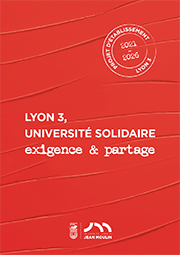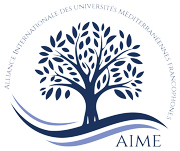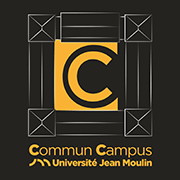AccueilRechercheProgrammes et productions scientifiquesThèsesThèses soutenuesThèses soutenues - 2006-2021Thèses soutenues - 2019
-
Partager cette page
- Recherche,
- Philosophie,
DANG Hyun- Sun
Anthropologie Culturelle de l’imaginaire coréen, l’apport de la méthodologie fran?aise
Publié le 30 avril 2019 – Mis à jour le 21 juillet 2020
Thèse en Philosophie, soutenue le 21 mars 2019.
Notre questionnement porte sur l’imaginaire coréen, et plus largement sur l’apport de l’anthropologie culturelle pour qui l’imaginaire permet de rendre compte de la société et de la culture coréennes. Notre méthodologie intègre l’apport des études philosophiques et anthropologiques des écoles fran?aises du XXe siècle, parce qu’elles éclairent notre réflexion sous un jour inédit et complémentaire aux travaux effectués en Corée. ? travers elles nous démontrons également que les symboles coréens ont aussi une portée universelle.
Notre matériau d’études est constitué par les images archétypales des textes littéraires coréens. Pour les analyser, nous nous appuyons sur les conceptions de l’image symbolique de Gaston Bachelard (1884-1962) et celle de l’anthropologie de l’imaginaire élaborée par Gilbert Durand (1921-2012). Tout en décrivant la rationalité scientifique, Bachelard valorise l’image mentale en la considérant comme une force créative et pas seulement comme un obstacle épistémologique. Il évoque plusieurs ? complexes ? dans son oeuvre sur l’imaginaire poétique dans une conception proche de celle de Carl Gustav Jung (1875-1961) pour qui le complexe ne se ramène pas à un blocage psychique mais inclut la créativité. Le complexe bachelardien se sépare ainsi pas de la pensée freudienne du pansexualisme. Quant à Durand, dans Les Structures anthropologiques de l’imaginaire (1960), il élabore une grammaire de l’imaginaire en proposant une trentaine de complexes qui viennent enrichir ceux établis par Bachelard, Otto Rank (1884-1939), Marie Bonaparte (1882-1962) ou Charles Baudouin (1893-1963). Pour Durand, la notion de complexe est comme celle de mythème, est la plus petite unité de discours mythiquement significative qui révèle un sympt?me psychique de l’inconscient collectif en tant que ? motif ?, ? thème ?, ou ? décor mythique ?. Durand développe sa Mythodologie dans sa deuxième période avec les deux concepts de mythocritique et de mythanalyse. La mythocritique est une méthode de critique littéraire et la mythanalyse est une méthode d’analyse socioculturelle de l’imaginaire, les deux se complétant.
Notre exploration de l’image littéraire de l’Antiquité au début du XXe siècle, y compris les mythes, les contes populaires et les légendes permettra de cerner l’identité culturelle du peuple coréen ainsi que l’universalité de la culture coréenne dans le cadre de l’anthropologie de l’imaginaire. Les deux axes qui caractérisent la mythologie coréenne sont le mythe de fondation de l’?tat et le mythe chamanique (le chant narratif du chaman). Pour le premier axe, la grande ?uvre du Samguk yusa (1283) est indispensable car elle relate deux mythes de fondation notamment, le mythe de fondation de l’?tat du royaume de Kojos?n et celui de Kogury?. Ces deux mythes sont référents en raison de leurs figures archétypales qui se déclinent avec le mythème de l’ours et celui de l’?uf et les personnages féminins divins d’Ungny? et d’Yu-hwa en relation avec ces mythèmes. Nous observons leurs redondances dans les époques
ultérieures, dans les récits de souffrances endurées par les femmes. L’histoire de Changhwa et Hongny?n sont exemplaires car elles induisent un fait social de la dynastie Chos?n qui marque la société coréenne en faisant de la figure féminine un bouc-émissaire du pouvoir masculin pris dans le système du patriarcat confucéen. Ce motif appara?t non seulement dans le récit de la ? princesse Pari ? sous la forme d’un chant chamanique mais aussi dans celui de ? Sim Ch’?ng ? exprimé sous la forme du rite chamanique, du p’ansori, du roman. Parmi les chansons folkloriques, la plus célèbre est Arirang ou Sijipsarinorae qui reprend également le même schéma du dépassement des souffrances moyennant un sentiment particulier et proprement coréen, le han (恨). Le Han a la particularité d’être dynamique et contradictoire car il est fondé
sur une dialectique subtile qui introduit une force vitale contre la résignation, la dépression, l’anxiété. Le Han est un élément de régulation de la société. Il a de fait, une valeur éthique et morale qui permet de gérer la violence ou la vengeance en tant que maux sociaux. Autrement dit, le Han participe de l’imagination symbolique générée par le peuple coréen. Notre trajet anthropologique entend ainsi montrer à la fois la part d’universalité et de singularité de l’imaginaire coréen moyennant les outils de G. Durand, dont le ? bassin sémantique ?.
The purpose of our investigation is the Korean imaginary, and more broadly the
contribution of cultural anthropology for which the imaginary explains Korean society and culture. Our methodology intergrates the contribution of philosophical and anthropological studies of French schools of the 20th century, as they illuminate the work done in Korea in a new and complementary light. Through them we will also demonstrate that Korean symbols are also universal in scope.
Our study material consists of archetypal images from Korean literary texts. To analyze
them, we will rely on the conceptions of symbolic imaginary thinking of Gaston Bachelard (1884-1962) as well as those of the anthropological of the imaginary elaborated by Gilbert Durand (1921-2012). All the while describing scientific rationality, Bachelard valued the mental image, considering it as a creative force and not only as an epistemological obstacle. He evoked several “complexes” in his work on poetic imaginary in a conception close to that of Carl Gustav Jung (1875-1961) for whom the notion of complex does not amount to a psychic block but includes creativity. The Bachelardian idea of complex therefore separates from Freudian thinking on pansexuality. According to Durand, in The Anthropological Structures of
the Imaginary (1960), the author elaborated a grammar of the imaginary by proposing thirty complexes that came to enrich those established by Bachelard, Otto Rank (1884-1939), Marie Bonaparte (1882-1962) and Charles Baudouin (1893-1963). For Durand, the notion of complex is like thant of the mytheme, the smallest unit of discourse mythically significant, which reveals a psychic symptom of the collective unconscious as “motif”, “theme”, or “mythical decor.” Durand develops his Mythodology in his second period with two concepts: mythocriticism and mythanalysis. Mythocriticism is a method of literary criticism, or rather a method of literary studies, and mythanalysis is a method of socio-cultural analysis of the imaginary, the two complementing the other.
Our exploration of the literary image from Antiquity to the start of the 20th century,
including myths, popular tales and legends, will allow us to determine the cultural identity of the Korean people as well as the universality of the Korean culture through anthropology of the imaginary. The two axes that characterize Korean mythology are the foundation of the state and the shamanic myth (the narrative song of the shaman). For the first axis, the great work of Samguk Yusa (1283) remains essential as it relates two foundational myths, notably the myth of the foundation of the Kingdom of Kojos?n and that of Kogury?. These two myths are references because their archetypal figures take the form of the mytheme of the bear and that of the egg and the divine feminine characters of Ungny? and Yu-hwa in relationship to these mythemes. We observe their repetitions in ulterior epochs, notably in the stories of suffering endured by women. The story of Changhwa and Hongny?n are exemplary as they induce social facts of the Chos?n Dynasty, which marks Korean society by making the female figure a scapegoat for masculine power in the Confusion patriarchal system. This motif appears not only in the story of the “Princess Pari” in the form of a Shamanic song but also in that of “Sim Ch’?ng” expressed in the form of shamanic rite, the p’ansori, the novel. Among folkloric songs, the most famous are those of Arirang or Sijipsarinorae which equally pick up on the same patterns of overcoming suffering through a particular and properly Korean feeling, the “han (恨)”. The Han has that distinction of being dynamic and contradictory as it is founded on a subtle dialectic that introduces a vital force against resignation, depression, and anxiety. The Han is an element of societal regulation. It has, in fact, an ethical and moral value, that makes it possible to manage violence or vengeance as social ills. Said in another way, the Han is part of the symbolic imagination generated by the Korean people. Our anthropological journey therefore intends to show both the part of universality and singularity of the Korean imaginary
with the tools of G. Durand, therefore of the “semantic bassin.”
Notre matériau d’études est constitué par les images archétypales des textes littéraires coréens. Pour les analyser, nous nous appuyons sur les conceptions de l’image symbolique de Gaston Bachelard (1884-1962) et celle de l’anthropologie de l’imaginaire élaborée par Gilbert Durand (1921-2012). Tout en décrivant la rationalité scientifique, Bachelard valorise l’image mentale en la considérant comme une force créative et pas seulement comme un obstacle épistémologique. Il évoque plusieurs ? complexes ? dans son oeuvre sur l’imaginaire poétique dans une conception proche de celle de Carl Gustav Jung (1875-1961) pour qui le complexe ne se ramène pas à un blocage psychique mais inclut la créativité. Le complexe bachelardien se sépare ainsi pas de la pensée freudienne du pansexualisme. Quant à Durand, dans Les Structures anthropologiques de l’imaginaire (1960), il élabore une grammaire de l’imaginaire en proposant une trentaine de complexes qui viennent enrichir ceux établis par Bachelard, Otto Rank (1884-1939), Marie Bonaparte (1882-1962) ou Charles Baudouin (1893-1963). Pour Durand, la notion de complexe est comme celle de mythème, est la plus petite unité de discours mythiquement significative qui révèle un sympt?me psychique de l’inconscient collectif en tant que ? motif ?, ? thème ?, ou ? décor mythique ?. Durand développe sa Mythodologie dans sa deuxième période avec les deux concepts de mythocritique et de mythanalyse. La mythocritique est une méthode de critique littéraire et la mythanalyse est une méthode d’analyse socioculturelle de l’imaginaire, les deux se complétant.
Notre exploration de l’image littéraire de l’Antiquité au début du XXe siècle, y compris les mythes, les contes populaires et les légendes permettra de cerner l’identité culturelle du peuple coréen ainsi que l’universalité de la culture coréenne dans le cadre de l’anthropologie de l’imaginaire. Les deux axes qui caractérisent la mythologie coréenne sont le mythe de fondation de l’?tat et le mythe chamanique (le chant narratif du chaman). Pour le premier axe, la grande ?uvre du Samguk yusa (1283) est indispensable car elle relate deux mythes de fondation notamment, le mythe de fondation de l’?tat du royaume de Kojos?n et celui de Kogury?. Ces deux mythes sont référents en raison de leurs figures archétypales qui se déclinent avec le mythème de l’ours et celui de l’?uf et les personnages féminins divins d’Ungny? et d’Yu-hwa en relation avec ces mythèmes. Nous observons leurs redondances dans les époques
ultérieures, dans les récits de souffrances endurées par les femmes. L’histoire de Changhwa et Hongny?n sont exemplaires car elles induisent un fait social de la dynastie Chos?n qui marque la société coréenne en faisant de la figure féminine un bouc-émissaire du pouvoir masculin pris dans le système du patriarcat confucéen. Ce motif appara?t non seulement dans le récit de la ? princesse Pari ? sous la forme d’un chant chamanique mais aussi dans celui de ? Sim Ch’?ng ? exprimé sous la forme du rite chamanique, du p’ansori, du roman. Parmi les chansons folkloriques, la plus célèbre est Arirang ou Sijipsarinorae qui reprend également le même schéma du dépassement des souffrances moyennant un sentiment particulier et proprement coréen, le han (恨). Le Han a la particularité d’être dynamique et contradictoire car il est fondé
sur une dialectique subtile qui introduit une force vitale contre la résignation, la dépression, l’anxiété. Le Han est un élément de régulation de la société. Il a de fait, une valeur éthique et morale qui permet de gérer la violence ou la vengeance en tant que maux sociaux. Autrement dit, le Han participe de l’imagination symbolique générée par le peuple coréen. Notre trajet anthropologique entend ainsi montrer à la fois la part d’universalité et de singularité de l’imaginaire coréen moyennant les outils de G. Durand, dont le ? bassin sémantique ?.
The purpose of our investigation is the Korean imaginary, and more broadly the
contribution of cultural anthropology for which the imaginary explains Korean society and culture. Our methodology intergrates the contribution of philosophical and anthropological studies of French schools of the 20th century, as they illuminate the work done in Korea in a new and complementary light. Through them we will also demonstrate that Korean symbols are also universal in scope.
Our study material consists of archetypal images from Korean literary texts. To analyze
them, we will rely on the conceptions of symbolic imaginary thinking of Gaston Bachelard (1884-1962) as well as those of the anthropological of the imaginary elaborated by Gilbert Durand (1921-2012). All the while describing scientific rationality, Bachelard valued the mental image, considering it as a creative force and not only as an epistemological obstacle. He evoked several “complexes” in his work on poetic imaginary in a conception close to that of Carl Gustav Jung (1875-1961) for whom the notion of complex does not amount to a psychic block but includes creativity. The Bachelardian idea of complex therefore separates from Freudian thinking on pansexuality. According to Durand, in The Anthropological Structures of
the Imaginary (1960), the author elaborated a grammar of the imaginary by proposing thirty complexes that came to enrich those established by Bachelard, Otto Rank (1884-1939), Marie Bonaparte (1882-1962) and Charles Baudouin (1893-1963). For Durand, the notion of complex is like thant of the mytheme, the smallest unit of discourse mythically significant, which reveals a psychic symptom of the collective unconscious as “motif”, “theme”, or “mythical decor.” Durand develops his Mythodology in his second period with two concepts: mythocriticism and mythanalysis. Mythocriticism is a method of literary criticism, or rather a method of literary studies, and mythanalysis is a method of socio-cultural analysis of the imaginary, the two complementing the other.
Our exploration of the literary image from Antiquity to the start of the 20th century,
including myths, popular tales and legends, will allow us to determine the cultural identity of the Korean people as well as the universality of the Korean culture through anthropology of the imaginary. The two axes that characterize Korean mythology are the foundation of the state and the shamanic myth (the narrative song of the shaman). For the first axis, the great work of Samguk Yusa (1283) remains essential as it relates two foundational myths, notably the myth of the foundation of the Kingdom of Kojos?n and that of Kogury?. These two myths are references because their archetypal figures take the form of the mytheme of the bear and that of the egg and the divine feminine characters of Ungny? and Yu-hwa in relationship to these mythemes. We observe their repetitions in ulterior epochs, notably in the stories of suffering endured by women. The story of Changhwa and Hongny?n are exemplary as they induce social facts of the Chos?n Dynasty, which marks Korean society by making the female figure a scapegoat for masculine power in the Confusion patriarchal system. This motif appears not only in the story of the “Princess Pari” in the form of a Shamanic song but also in that of “Sim Ch’?ng” expressed in the form of shamanic rite, the p’ansori, the novel. Among folkloric songs, the most famous are those of Arirang or Sijipsarinorae which equally pick up on the same patterns of overcoming suffering through a particular and properly Korean feeling, the “han (恨)”. The Han has that distinction of being dynamic and contradictory as it is founded on a subtle dialectic that introduces a vital force against resignation, depression, and anxiety. The Han is an element of societal regulation. It has, in fact, an ethical and moral value, that makes it possible to manage violence or vengeance as social ills. Said in another way, the Han is part of the symbolic imagination generated by the Korean people. Our anthropological journey therefore intends to show both the part of universality and singularity of the Korean imaginary
with the tools of G. Durand, therefore of the “semantic bassin.”
Mots-clés : Archétypologie, Anthropologie de l’imaginaire, bassin sémantique,
chamanisme coréen, complexe, Gaston Bachelard, Gilbert Durand, han (恨), image poétique, imagination symbolique, mythanalyse, mythème, mythocritique, mythologie coréenne, Samguk yusa, structuralisme figuratif
Keywords : Archetypology, Anthropology of the imaginary, semantique bassin, Korean shamanism, complex, Gaston Bachelard, Gilbert Durand, han (恨), poetry image, symbolic imagination, mythanalyse, mytheme, mythocritique, Korean mythology, Samguk yusa,
figurative structuralism.
Directeur(trice) de thèse : Jean-Jacques WUNENBURGER
Membres du jury :
- M. Jean-Jacques WUNENBURGER, Directeur de thèse, Professeur des universités émérite, Université Jean Moulin Lyon 3,
- M. Dae-Yeol KIM, Co-directeur de thèse, Professeur des universités, INALCO Paris,
- M. Ionel BUSE, Professeur, Université de Craiova, Roumanie,
- M. Philippe WALTER, Professeur des universités émérite, Université Grenoble,
- M. Benjamin JOINAU, Professeur adjoint (MCF), Université Hong-ik, Séoul Corée du Sud.
Président (e) du jury : Philippe WALTER
Documentation
Mise à jour : 21 juillet 2020







